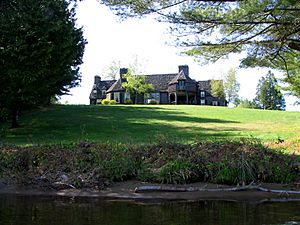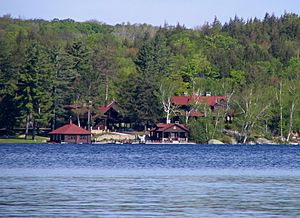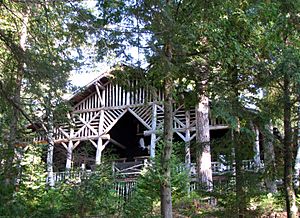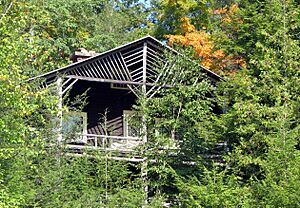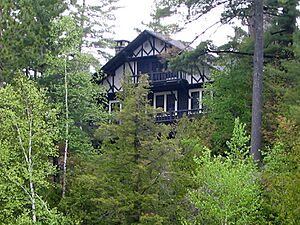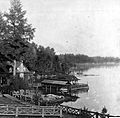Upper Saranac Lake facts for kids
Quick facts for kids Upper Saranac Lake |
|
|---|---|
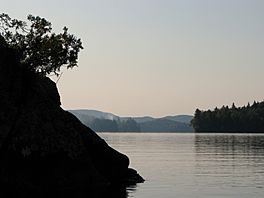
Looking south near Eagle Island
|
|
| Location | Adirondacks, Franklin County, New York, United States |
| Coordinates | 44°17′41″N 74°19′14″W / 44.2947976°N 74.3205178°W, 44°14′21″N 74°19′18″W / 44.2390918°N 74.3217165°W |
| Type | Lake |
| Primary outflows | Saranac River |
| Basin countries | United States |
| Max. length | 8 mi (13 km) |
| Max. width | 2 mi (3.2 km) |
| Surface area | 5,250 acres (2,120 ha) |
| Shore length1 | 37 mi (60 km) |
| Surface elevation | 1,572 ft (479 m) |
| Islands | 18 |
| Settlements | Saranac Inn (hamlet) |
| 1 Shore length is not a well-defined measure. | |
Upper Saranac Lake is a beautiful lake in the Adirondacks of northern New York. It's one of three connected lakes that are part of the Saranac River. You can find it near the village of Saranac Lake.
This lake is quite large, ranking as the sixth biggest in the Adirondacks. If you love paddling, you can travel about 17-mile (27 km) across Upper, Middle, and Lower Saranac Lakes. There's only one short "carry" (where you have to carry your boat) needed! You can also find 20 simple campsites here, perfect for boaters.
The lake has 37 mi (60 km) of shoreline. More than half of this land is privately owned. Many "camps" line the shores, from huge, fancy Great Camps to smaller vacation cottages. Upper Saranac Lake is also part of the Northern Forest Canoe Trail. This long trail stretches 740 miles (1,190 km) from Old Forge, NY to Fort Kent, ME.
Contents
A Journey Through Time: Upper Saranac Lake's History
Early Travel and Lodges
Before cars and trains, the Saranac Lakes were a key travel route in the Adirondacks. People could journey about 140 miles (230 km) by water. This path went from Old Forge all the way to Lake Champlain.
The first places to stay on the lake were built for visitors who loved hunting and fishing. Around 1850, the Rustic Lodge opened at Indian Carry. It offered rooms, meals, and guides. Bartlett's, another similar place, was built soon after. These spots helped people move their boats between lakes. Indian Carry connected Upper Saranac Lake to Stony Creek Ponds and the Raquette River. Bartlett's Carry linked Upper Saranac Lake to Middle Saranac Lake.
Grand Hotels and Famous Guests
In 1889, the Wawbeek Lodge opened on the southwest shore. It was a luxurious hotel with cottages and even fancy tents. Guests could enjoy beautiful views and comfortable stays. However, it closed in 1914 because it was expensive to run. Also, more people started buying their own private camps. A smaller hotel was built on the same spot later.
The northern end of the lake was home to the Saranac Inn. This famous inn opened in 1864 and stayed open until 1962. At its busiest, it could host a thousand guests! Important people like US Presidents Grover Cleveland and Chester A. Arthur stayed there. New York Governor Charles Evans Hughes also visited. Sadly, the inn burned down in 1978.
The Great Camps of Upper Saranac Lake
Many large, beautiful summer homes, known as Great Camps, were built around the lake. These were often like small villages, with many buildings.
Eagle Island Camp: A Historic Retreat
Camp Eagle Island was built in 1899. It was a summer home for Levi P. Morton, who was a New York Governor and later a US Vice-President. The camp was designed by a famous architect named William L. Coulter. Since 1938, Camp Eagle Island has been a Girl Scout camp. It's so special that it was named a National Historic Landmark in 2004.
Other Notable Great Camps
Two other Great Camps on the lake were Moss Ledge and Prospect Point Camp. These were also designed by William L. Coulter. Prospect Point Camp later became a lodge called Sekon in the Pines. Then, it was used as a summer camp for young girls. Since 1969, a Christian group called Young Life has used it for educational camping trips.
The End of an Era
After World War I and during the Great Depression, it became harder to keep up these large Great Camps. Many were left empty, lost due to unpaid taxes, or fell apart. However, some of the cottages and Great Camps built around Saranac Inn still exist today.
Images for kids
-
View from the Wawbeek, 1912. The steam launch in the foreground was used to shuttle guests to the hotel from the railway near Saranac Inn.




